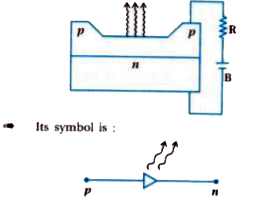Explain the design, working, uses and benefits of light emitting diode. Solution in Gujrati
It is a heavily doped p-n junction which under forward bias emits spontaneous radiation, hence diode have to provide forward bias to operate.
The diode is encapsulated with transparent cover so that emitted light can come out. The outline of the LED is shown in figure.

When the diode is forward biased, electrons are sent from n→p where they are minority carriers and hole are sent from p→n where they are minority carriers.
At the junction boundary the concentration of minority crriers increases when there no bias.
Thus at the junction boundary on either side of the junction, excess minority carriers are there which recombine with majority carriers near the junction as a result, the energy is released in the form of photons.
Photons with energy equal to or slightly less than the band gap are emitted.
When the forward current of the diode is small, the intensity of light emitted is small. As the forward current increases, intensity of light increases and reaches a maximum.
Further increase in the forward current results in decrease of light intensity. LED are biased such that the light emitting efficiency is maximum.
The V-I characteristics of a LED is similar to that of a Si junction diode. But the threshold voltages are much higher and slightly different for each colour.
The reverse breakdown voltages of LED are very low, typically around 5V. So care should be taken that high reverse voltages do not appear across them.
LEDs that can emit red, yellow, orange, green and blue light are commercially available.
The semiconductor used for fabrication of visible LEDs must at least have a band gap Eg of 1.8eV (spectral range of visible light is from about 0.4 μm to 0.7μm, that is from about 3 eV to 1.8eV).
Hence Eg1=hcλ1andEg2=hcλ2
=6.625×10−34×3×1084×10−7×1.6×10−19eV
=3.10eV
=3eV
and Eg2=hcλ2=6.625×10−34×3×1087×10−7×1.6×10−19eV
=1.774eV
=1.8eV
The compound semiconductor Gallium Arsenide phosphide [GaAs1−xPx] is used for making LEDs of different colours.
GaAs0.6P0.4[Eg=1.9eV] is used for red LED.
GaAs [Eg=1.4eV] is used for making infrared LED.
The uses of LED are in remote controls, burglar alarm systems (For prevent stealing) optical communication.
Extensive research is being done for developing white LEDs which can replace incandecent lamps.
LEDs have following advantages over conventional incandescent low power lamps.
(1) Low operational voltage and less power.
(2) Fast action and no warm-up time required.
(3) The bandwidth of emitted light is 100 Å to 500 Å or in other words it is nearly monochromatic.
(4) Long life and ruggedness.
(5) Fast ON/OFF switching capability.
Topper's Solved these Questions
- BOOK - KUMAR PRAKASHANCHAPTER - SEMICONDUCTOR ELECTRONICS : MATERIALS, DEVICES AND SIMPLE CIRCUITS EXERCISE - Section-B : Numericals (Numerical From Textual illustrations)16videos
SEMICONDUCTOR ELECTRONICS : MATERIALS, DEVICES AND SIMPLE CIRCUITS
- BOOK - KUMAR PRAKASHANCHAPTER - SEMICONDUCTOR ELECTRONICS : MATERIALS, DEVICES AND SIMPLE CIRCUITS EXERCISE - Section-B : Numericals (Numerical From Textual Exercise)15videos
SEMICONDUCTOR ELECTRONICS : MATERIALS, DEVICES AND SIMPLE CIRCUITS
- BOOK - KUMAR PRAKASHANCHAPTER - SEMICONDUCTOR ELECTRONICS : MATERIALS, DEVICES AND SIMPLE CIRCUITS EXERCISE - Section-D : Multiple Choice Questions (MCQs) (MCQs asked in Competitive Exams)129videos
SEMICONDUCTOR ELECTRONICS : MATERIALS, DEVICES AND SIMPLE CIRCUITS
- BOOK - KUMAR PRAKASHANCHAPTER - SAMPLE QUESTION PAPER EXERCISE - PART-B SECTION-C5videos
SAMPLE QUESTION PAPER
- BOOK - KUMAR PRAKASHANCHAPTER - WAVE OPTICSEXERCISE - SECTION-D (MULTIPLCE CHOICE QUESTIONS (MCQS)) (MCQS FROM DARPAN BASED ON TEXTBOOK)239videos
WAVE OPTICS
Similar Questions
C, Si and Ge have same lattice structure. Why is C insulator while Si and Ge intrinsic semiconductors?
04:58View SolutionIn an n type silicon, which of the following statements is true:
01:13View SolutionAt absolute zero temperature Si acts as ……..
02:55View SolutionTwo charges –q and +q are located at points (0, 0, –a) and (0, 0, a), respectively.
(a) What is the electrostatic potential at the points (0, 0, z) and (x, y, 0) ?
(b) Obtain the dependence of potential on the distance r of a point from the origin when r/a>>1 .
(c) How much work is done in moving a small test charge from the point (5,0,0) to (–7,0,0) along the x-axis? Does the answer change if the path of the test charge between the same points is not along the x-axis?03:19View SolutionAccording to particle theory of light what is the velocity of light in a dense medium, compared to that in rare medium ?
01:32View SolutionLight Emitting Diode
04:02View SolutionWhat is a light - emitting diode?
13:16View SolutionA light emitting diode is shown as
03:16View SolutionA light emitting diode is
04:39View Solutionप्रकाश उत्सर्जन डायोड का उपयोग ..............……. होता है।
01:20View Solutionप्रकाश उत्सर्जक डायोड की संरचना तथा कार्य-विधि समझाइए।
14:36View Solutionप्रकाश उत्सर्जक डायोड (LED) क्या है ? इसका कार्य सिद्धान्त समझाइए तथा बताइए कि उत्सर्जक प्रकाश का रंग किस पर निर्भर करता है ?
01:44View Solutionप्रकाश उत्सर्जन डायोड बनाया जाता है
View Solutionप्रकाश उत्सर्जक डायोड (LED) के रूप में प्रयुक्त करने के लिए डायोड के निर्माण में किन महत्मपूर्ण बातों के ध्यान रखा जाता है ?
04:13View Solutionप्रकाश उत्सर्जक डायोड का उपयोग कहाँ करते है?
03:51View Solution
